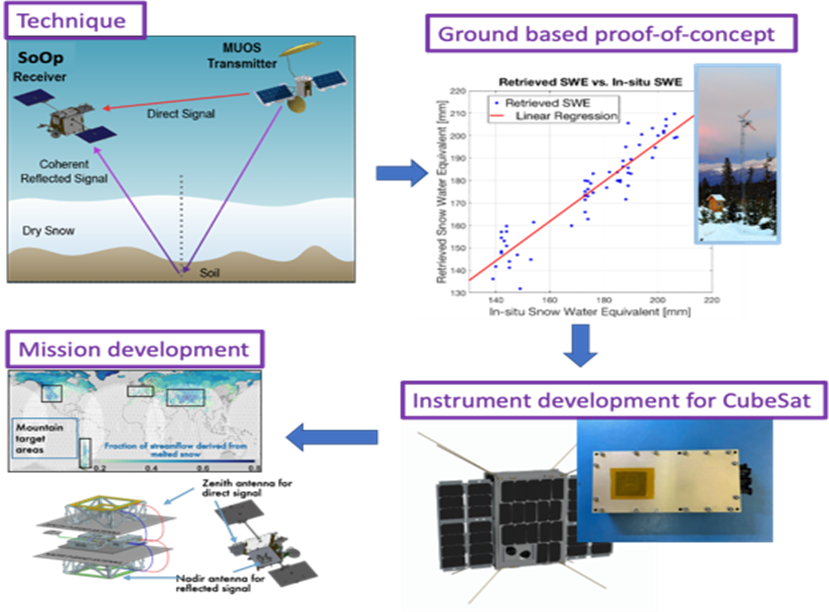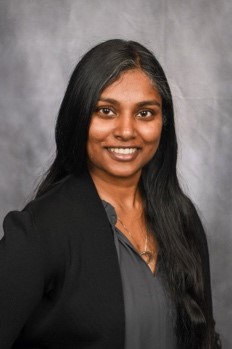Land and Ocean Remote Sensing Using Signals of Opportunity Reflectometry

Reflectometry is a new approach to microwave remote sensing that utilizes signals of opportunity (SoOp). In this technique, the powerful active navigation and/or digital communication transmitters are re-utilized as illuminators in a bistatic radar configuration. This technique represents similar features of both active radar and passive radiometry, while showing some promise in circumventing some problems in each of those two techniques. The use of existing sources means that the reflectometry instruments are smaller and consume order of magnitude lower power than radars. At the same time, the surface resolution is determined by either the transmitter bandwidth or the transmitting frequency and not the antenna size as in radiometry. Furthermore, measurements can be made in any band presently occupied by a transmitter and are not limited only to the spectrum allocated for scientific applications.
This presentation will primarily cover current ongoing SoOp projects at JPL. The first one is to use P-band signal for measurement of snow properties (snow water equivalent and snow depth) and soil properties (root zone soil moisture). An overview of SNOOPI CubeSat mission and airborne SoOpSAR campaign will also be provided. And the second one is to use Ku/Ka wideband (>400 MHz) signal to measure ocean properties (sea surface height).
Date and Time
Location
Hosts
Registration
-
 Add Event to Calendar
Add Event to Calendar
- Rochester Institute of Technology
- 54 Lomb Memorial Drive
- Rochester, New York
- United States 14623
- Building: Center for Imaging Science - Bldg 76
- Room Number: Auditorium
- Click here for Map
Speakers
 Rashmi Shah of Jet Propulsion Laboratory (JPL)
Rashmi Shah of Jet Propulsion Laboratory (JPL)
Land and Ocean Remote Sensing Using Signals of Opportunity Reflectometry
Reflectometry is a new approach to microwave remote sensing that utilizes signals of opportunity (SoOp). In this technique, the powerful active navigation and/or digital communication transmitters are re-utilized as illuminators in a bistatic radar configuration. This technique represents similar features of both active radar and passive radiometry, while showing some promise in circumventing some problems in each of those two techniques. The use of existing sources means that the reflectometry instruments are smaller and consume order of magnitude lower power than radars. At the same time, the surface resolution is determined by either the transmitter bandwidth or the transmitting frequency and not the antenna size as in radiometry. Furthermore, measurements can be made in any band presently occupied by a transmitter and are not limited only to the spectrum allocated for scientific applications.
This presentation will primarily cover current ongoing SoOp projects at JPL. The first one is to use P-band signal for measurement of snow properties (snow water equivalent and snow depth) and soil properties (root zone soil moisture). An overview of SNOOPI CubeSat mission and airborne SoOpSAR campaign will also be provided. And the second one is to use Ku/Ka wideband (>400 MHz) signal to measure ocean properties (sea surface height).
Biography:
Rashmi Shah received B.S. in Electrical Engineering in 2007 from Rochester Institute of Technology and M.S. and Ph.D. in Aeronautical and Astronautical Engineering from Purdue University, West Lafayette, IN, USA, in 2010 and 2014, respectively. Since 2014, she has been at Jet Propulsion Laboratory (JPL), California Institute of Technology (Caltech), Pasadena, CA, USA as a Research Technologist in the Tracking Systems and Applications Section. In Nov. 2021, she was also appointed as the JPL’s first Associate Directorate Technologist for JPL’s Earth Science and Technology Directorate. Her background and interests are microwave remote sensing, electromagnetic scattering, land and ocean remote sensing using signals of opportunity reflectometry and microwave remote sensing instrument development, as well as science systems engineering. Dr. Shah is the recipient of NASA Early Career Public Achievement Medal and Institute of Electrical and Electronics Engineers (IEEE) Geoscience and Remote Sensing Society’s (GRSS) Early Career Award.
Email:

